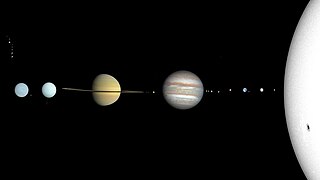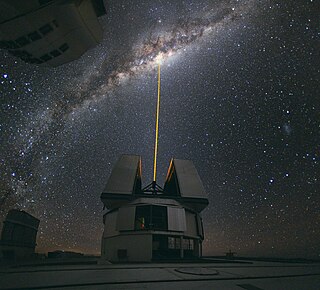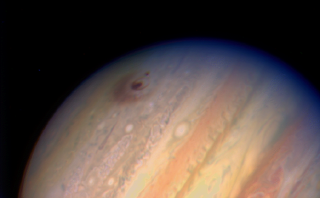Related Research Articles

A comet is an icy, small Solar System body that warms and begins to release gases when passing close to the Sun, a process called outgassing. This produces an extended, gravitationally unbound atmosphere or coma surrounding the nucleus, and sometimes a tail of gas and dust gas blown out from the coma. These phenomena are due to the effects of solar radiation and the outstreaming solar wind plasma acting upon the nucleus of the comet. Comet nuclei range from a few hundred meters to tens of kilometers across and are composed of loose collections of ice, dust, and small rocky particles. The coma may be up to 15 times Earth's diameter, while the tail may stretch beyond one astronomical unit. If sufficiently close and bright, a comet may be seen from Earth without the aid of a telescope and can subtend an arc of up to 30° across the sky. Comets have been observed and recorded since ancient times by many cultures and religions.

The Solar System is the gravitationally bound system of the Sun and the objects that orbit it. The largest of such objects are the eight planets, in order from the Sun: four terrestrial planets, named Mercury, Venus, Earth and Mars; and four giant planets, including two gas giants, Jupiter and Saturn, and two ice giants, named Uranus and Neptune. The terrestrial planets have a definite surface and are mostly made of rock and metal. The gas giants are mostly made of hydrogen and helium, while the ice giants are mostly made of volatile substances such as water, ammonia, and methane. In some texts, these terrestrial and giant planets are called the inner Solar System and outer Solar System planets respectively.

Astronomy is a natural science that studies celestial objects and phenomena. It uses mathematics, physics, and chemistry in order to explain their origin and evolution. Objects of interest include planets, moons, stars, nebulae, galaxies, meteoroid, asteroid, and comets. Relevant phenomena include supernova explosions, gamma ray bursts, quasars, blazars, pulsars, and cosmic microwave background radiation. More generally, astronomy studies everything that originates beyond Earth's atmosphere. Cosmology is a branch of astronomy that studies the universe as a whole.

Planetesimals are solid objects thought to exist in protoplanetary disks and debris disks. Per the Chamberlin–Moulton planetesimal hypothesis, they are believed to form out of cosmic dust grains. Believed to have formed in the Solar System about 4.6 billion years ago, they aid study of its formation.

Astrophysics is a science that employs the methods and principles of physics and chemistry in the study of astronomical objects and phenomena. As one of the founders of the discipline, James Keeler, said, Astrophysics "seeks to ascertain the nature of the heavenly bodies, rather than their positions or motions in space–what they are, rather than where they are." Among the subjects studied are the Sun, other stars, galaxies, extrasolar planets, the interstellar medium and the cosmic microwave background. Emissions from these objects are examined across all parts of the electromagnetic spectrum, and the properties examined include luminosity, density, temperature, and chemical composition. Because astrophysics is a very broad subject, astrophysicists apply concepts and methods from many disciplines of physics, including classical mechanics, electromagnetism, statistical mechanics, thermodynamics, quantum mechanics, relativity, nuclear and particle physics, and atomic and molecular physics.

Jan Hendrik Oort was a Dutch astronomer who made significant contributions to the understanding of the Milky Way and who was a pioneer in the field of radio astronomy. The New York Times called him "one of the century's foremost explorers of the universe"; the European Space Agency website describes him as "one of the greatest astronomers of the 20th century" and states that he "revolutionised astronomy through his ground-breaking discoveries." In 1955, Oort's name appeared in Life magazine's list of the 100 most famous living people. He has been described as "putting the Netherlands in the forefront of postwar astronomy."
Richard Martin West is a Danish astronomer and discoverer of astronomical objects with a long career at the European Southern Observatory (ESO) and at the International Astronomical Union (IAU).

Alexandra is a carbonaceous asteroid from the intermediate asteroid belt, approximately 155 kilometers in diameter. It was discovered by German-French astronomer Hermann Goldschmidt on 10 September 1858, and named after the German explorer Alexander von Humboldt; it was the first asteroid to be named after a male.

In astrophysics, accretion is the accumulation of particles into a massive object by gravitationally attracting more matter, typically gaseous matter, into an accretion disk. Most astronomical objects, such as galaxies, stars, and planets, are formed by accretion processes.
Michael G. L. Baillie is Professor Emeritus of Palaeoecology at Queen's University of Belfast, in Northern Ireland. Baillie is a leading expert in dendrochronology, or dating by means of tree-rings. In the 1980s, he was instrumental in building a year-by-year chronology of tree-ring growth reaching 7,400 years into the past.

The following outline is provided as an overview of and topical guide to astronomy:
Jitendra Jatashankar Rawal is an Indian astrophysicist and scientific educator, recognized for his work in the popularisation of science.
William M. Napier is the author of five high tech thriller novels and a number of nonfiction science books.
Scott Duncan Tremaine is a Canadian-born astrophysicist. He is a fellow of the Royal Society of London, the Royal Society of Canada and the National Academy of Sciences. Tremaine is widely regarded as one of the world's leading astrophysicists for his contributions to the theory of Solar System and galactic dynamics. Tremaine is the namesake of asteroid 3806 Tremaine. He is credited with coining the name "Kuiper belt".

Charles Leroy Ellenberger is perhaps best known as a one-time advocate, but now a critic of, controversial writer Immanuel Velikovsky and his works on catastrophism. He first read Worlds in Collision in 1969. In 1979, he became a contributing editor to the Velikovsky-inspired Kronos journal, and has contributed material to many other publications. In 1980 he was selected by the editor of Astronomy magazine to debate James Oberg on Velikovsky.
Andrew Christopher Fabian is a British astronomer and astrophysicist. He was Director of the Institute of Astronomy, University of Cambridge from 2013 to 2018. He was a Royal Society Research Professor at the Institute of Astronomy, Cambridge from 1982 to 2013, and Vice-Master of Darwin College, Cambridge from 1997 to 2012. He served as president of the Royal Astronomical Society from May 2008 through to 2010.
Dr. Walter F. Huebner was an astrophysicist who wrote several books on comets including close-orbit and asteroids that may collide with the Earth, and how to prevent catastrophic collisions.
Kazimieras Černis is a Lithuanian astronomer and astrophysicist, active member of the IAU, and a prolific discoverer of minor planets and comets. In 2012, he discovered 420356 Praamzius, a trans-Neptunian object and dwarf planet candidate.

In modern times, numerous impact events on Jupiter have been observed, the most significant of which was the collision of Comet Shoemaker–Levy 9 in 1994. Jupiter is the most massive planet in the Solar System and thus has a vast sphere of gravitational influence, the region of space where an asteroid capture can take place under favorable conditions.
References
- ↑ Description of Clube in The Cosmic Serpent, by Victor Clube and Bill Napier. Published by Faber and Faber, London, 1982
- ↑ "Player profile: Stace Clube". ESPNcricinfo . Retrieved 24 October 2014.
- ↑ Bolton, Geoffrey (1962). History of the O.U.C.C. (First ed.). Oxford: Holywell Press Ltd. pp. 339–340.
- ↑ "Fisher Room: Thesis List". Department of Physics, University of Oxford. Archived from the original on 7 January 2018. Retrieved 26 October 2014.
- ↑ Schmadel, Lutz D. (ed.). "(6523) Clube". Dictionary of Minor Planet Names. Springer.
- ↑ Morrison, David (1997). Is the Sky Falling? Skeptical Inquirer , 21 (3), 22-28.